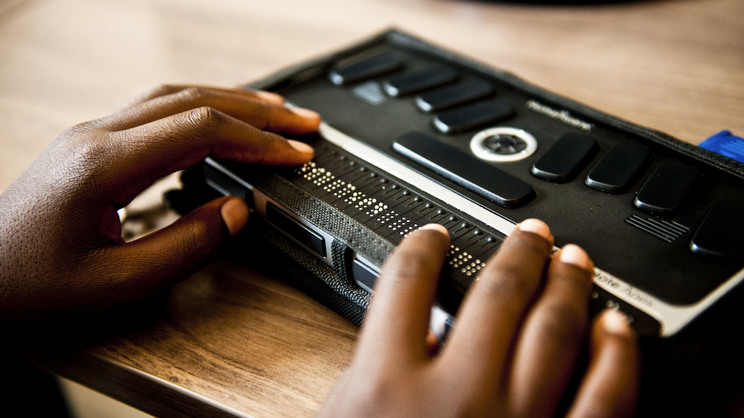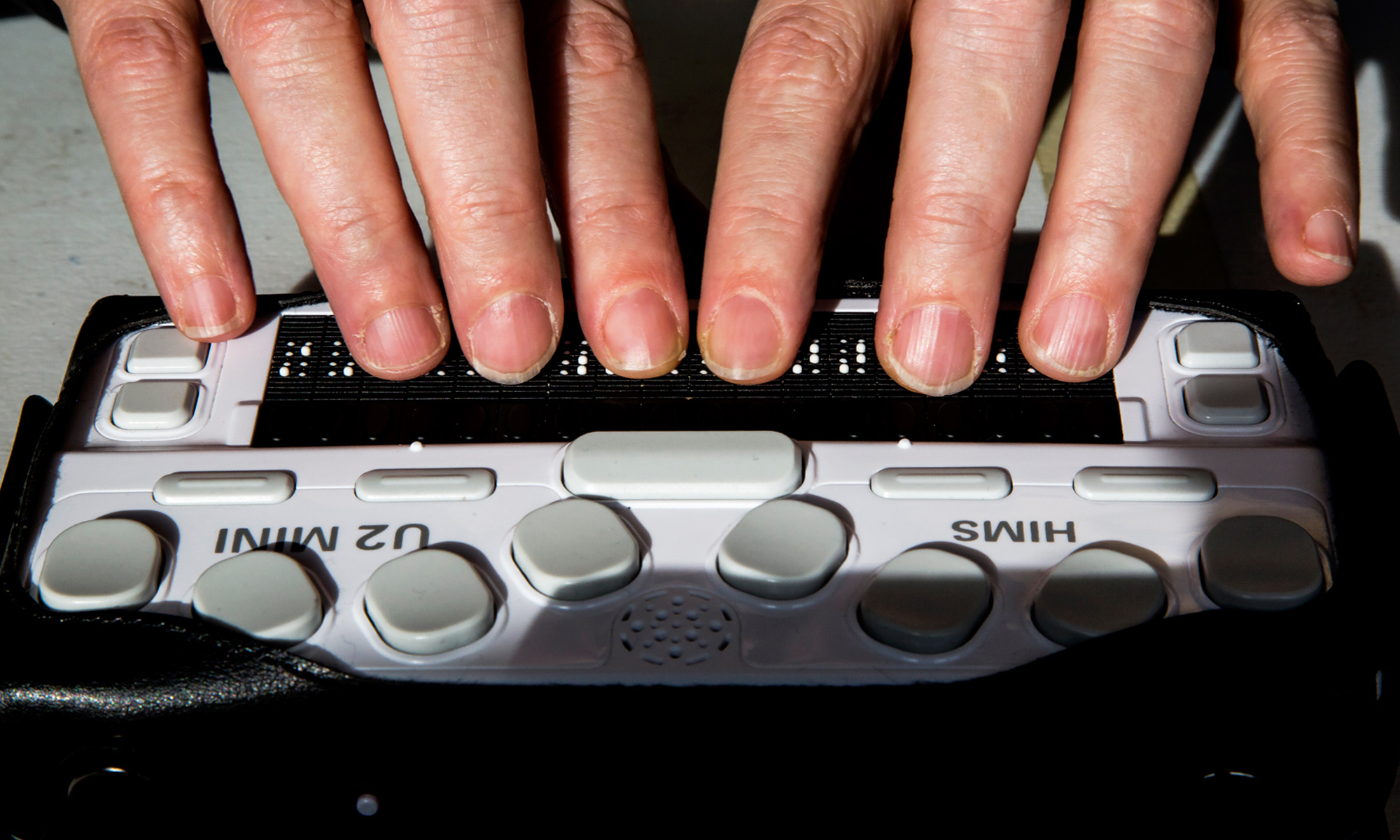Enhance Accessibility with Braille Tools and Notetakers
An Overview to Life-Changing Assistive Innovation for the Blind and Aesthetically Impaired
The development of assistive innovation has ushered in a transformative age for individuals who are visually impaired or blind, offering tools that improve autonomy and enhance everyday experiences. Developments such as wise navigation gadgets and AI-driven applications are redefining exactly how individuals engage with their surroundings, while available analysis remedies and wise home technologies promise to additional raise the top quality of life.
Smart Navigating Equipment
Smart navigating tools are changing the method individuals who are blind or visually damaged connect with their atmosphere. These innovative innovations, which incorporate GPS, audio responses, and haptic signals, offer customers with crucial details about their environments, boosting their self-reliance and flexibility.
One popular instance is making use of wise walking canes equipped with sensors that identify obstacles and supply real-time responses through resonances or audio signs. These tools enable individuals to browse intricate environments, such as hectic roads or crowded public rooms, with enhanced confidence. In addition, wearable tools, such as smart glasses, are being established to help in identifying faces, reading text, and determining items, better augmenting the user's spatial understanding.
Moreover, clever navigating devices are increasingly incorporating synthetic intelligence to examine information and adjust to customers' choices. This tailored strategy not just boosts navigating performance but also fosters a sense of empowerment amongst customers. As modern technology proceeds to advance, the possibility for clever navigating devices to produce a much more easily accessible and inclusive world for individuals who are aesthetically damaged or blind stays appealing, ultimately reshaping their day-to-day experiences and communications.
Ingenious Mobile Apps
Mobile applications are becoming effective devices for helping individuals who are blind or aesthetically damaged, supplying an array of performances that improve daily living. These apps harness progressed innovation to help with everyday jobs, enhance ease of access, and promote freedom.
One classification of innovative mobile applications focuses on visual acknowledgment. Applications like Be My Eyes link users with sighted volunteers by means of video calls, making it possible for real-time support for jobs such as checking out tags or browsing unknown atmospheres. Apps like Seeing AI utilize fabricated intelligence to describe environments, read text, and recognize items, giving individuals with vital information at their fingertips.
An additional considerable location is navigation and orientation. Applications such as Aira and Nearby Traveler give audio assistance, helping individuals browse metropolitan spaces effortlessly. They offer personalized assistance, permitting for a much more positive expedition of the environment.
Additionally, health and wellness applications cater to particular requirements, such as drug management and physical fitness monitoring. These applications intend to foster an alternative technique to health, ensuring that users can preserve their health and wellness individually.
Wearable Assistive Devices
Wearable assistive devices represent a considerable improvement in modern technology made to sustain individuals that are blind or aesthetically damaged. These devices improve flexibility and self-reliance by providing real-time responses concerning the surrounding environment. Among the most notable wearable innovations are smart glasses furnished with electronic cameras and sensing units, which can recognize challenges and relay critical details via audio hints.

Another innovative option includes wrist-worn gadgets that use ultrasonic waves to identify obstacles and provide navigational support. These gadgets commonly feature personalized setups, permitting customers to customize the signals to their specific needs.
The integration of artificial intelligence in wearable assistive technology is also noteworthy, as it continually improves the precision and responsiveness of these tools. On the whole, wearable assistive tools are changing the lives of the blind and aesthetically damaged, fostering better freedom and improving high quality of life with innovative solutions.
Accessible Reviewing Solutions
Obtainable analysis options play a vital function in enabling individuals that are blind or aesthetically impaired to engage with text throughout different formats. These remedies incorporate a series of devices and technologies created to improve reading experiences, from standard print materials to digital web content.
One noticeable option is Optical Character Recognition (OPTICAL CHARACTER RECOGNITION) modern technology, which converts published text right into electronic style, allowing customers to listen to or review the content utilizing screen viewers. In addition, specialized e-readers geared up with text-to-speech capabilities offer customizable reading experiences, making it possible for customers to adjust font dimensions and history colors for boosted visibility.
An additional effective approach is braille displays, which provide responsive feedback by converting electronic text into braille. This permits individuals to check out touch, promoting greater self-reliance and accessibility to literature. Mobile applications designed for checking out checked books or files can equip customers with instant access to a large collection of products (Voice-activated assistive devices).

Smart Home Technologies
Smart home modern technologies have revolutionized the method people who are visually damaged or blind communicate with their living settings, enhancing both self-reliance and safety. These ingenious remedies leverage automation and connection to develop an available home tailored to the requirements of customers.
Smart speakers and voice-activated assistants supply hands-free control over various devices, enabling customers to adjust safety, temperature level, and lights measures with basic voice commands. This capability minimizes reliance on sighted support and promotes a feeling of freedom. In addition, clever lights systems can be tailored to supply acoustic responses or responsive signs, enabling people to browse their homes better.
Moreover, safety and security systems geared up with smart video cameras and sensors can send real-time alerts to users, improving personal security without necessitating visual confirmation. Automated door locks offer assurance, permitting individuals to protect their homes effortlessly.
Integrating clever home modern technologies not just enhances everyday living but also urges social communication with connected tools - Screen readers for the blind. With continuous advancements in assistive modern technology, the future shows up promising, as even more remedies will emerge to more encourage individuals who are aesthetically damaged or blind, guaranteeing a more comprehensive and independent way of life
Conclusion
In final thought, the advancements in assistive innovation for the aesthetically impaired and blind represent a substantial leap towards enhancing self-reliance and top quality of life. Smart navigation devices, cutting-edge mobile applications, wearable devices, obtainable reading options, and clever home technologies collectively promote a comprehensive atmosphere. This assimilation of modern technology not only improves movement and everyday living yet additionally encourages individuals to engage fully with their surroundings, promoting higher autonomy and involvement in culture.
Advancements such as smart navigation devices and AI-driven applications are redefining just how individuals communicate with their surroundings, while easily accessible reading services and smart home technologies promise to further raise the quality of life. As technology continues to breakthrough, the potential for clever navigating devices to develop an extra easily accessible and comprehensive world for individuals who are blind or aesthetically damaged remains promising, inevitably improving their everyday experiences and interactions.
Wearable assistive devices stand for a substantial improvement in innovation developed to sustain people who are aesthetically impaired or blind. Amongst the most significant wearable innovations are smart glasses outfitted with electronic cameras and sensors, which can determine obstacles and relay crucial details with audio hints.
Smart navigation devices, ingenious mobile applications, wearable devices, easily accessible reading remedies, and wise home technologies jointly promote a comprehensive Speech-to-text devices for low vision atmosphere.